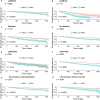Coronary Microvascular Disease Assessed by 82-Rubidium Positron Emission Tomography Myocardial Perfusion Imaging Is Associated With Small Vessel Disease of the Kidney and Brain
- PMID: 37318021
- PMCID: PMC10356029
- DOI: 10.1161/JAHA.122.028767
Coronary Microvascular Disease Assessed by 82-Rubidium Positron Emission Tomography Myocardial Perfusion Imaging Is Associated With Small Vessel Disease of the Kidney and Brain
Abstract
Background Coronary microvascular disease (CMD) may be part of a systemic small vessel disease that also manifests as neurological impairment and kidney disease. However, clinical evidence supporting a potential link is scarce. We assessed whether CMD is associated with an increased risk of small vessel disease in the kidney and brain. Methods and Results A retrospective multicenter (n=3) study of patients clinically referred to 82-rubidium positron emission tomography myocardial perfusion imaging was conducted between January 2018 and August 2020. Exclusion criterion was reversible perfusion defects >5%. CMD was defined as myocardial flow reserve (MFR) ≤2. The primary outcome, microvascular event, was defined by hospital contact for chronic kidney disease, stroke, or dementia. Among 5122 patients, 51.7% were men, median age 69.0 [interquartile range, 60.0-75.0] years, 11.0% had left ventricular ejection fraction ≤40%, and 32.4% had MFR ≤2. MFR was associated with baseline estimated glomerular filtration rate after multivariable adjustment (β=0.04 [95% CI, 0.03-0.05]; P<0.001). During a median follow-up of 3.05 years, 383 (7.5%) patients suffered an event (253 cerebral and 130 renal), more frequently in patients with MFR ≤2 versus MFR >2 (11.6% versus 5.5%, P<0.001). MFR ≤2 was associated to outcome with a hazard ratio (HR) of 2.30 (95% CI, 1.88-2.81, P<0.001) and an adjusted HR of 1.62 (95% CI, 1.32-2.00, P<0.001). Results were consistent across subgroups defined by presence of irreversible perfusion defects, estimated glomerular filtration rate, diabetes, left ventricular ejection fraction, and previous revascularization. Conclusions This is the first large-scale cohort study to link CMD to microvascular events in the kidney and brain. Data support the hypothesis that CMD is part of a systemic vascular disorder.
Keywords: cardiac PET; imaging; microvascular flow reserve; myocardial perfusion; small vessel disease.
Figures



References
Publication types
MeSH terms
Substances
LinkOut - more resources
Full Text Sources
Medical

